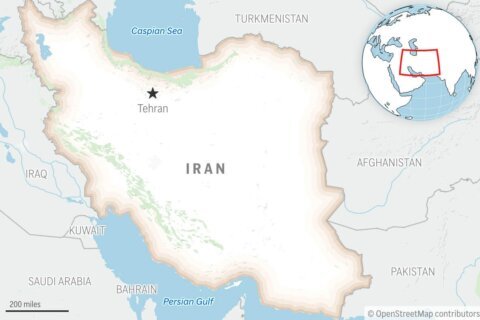WTOP’s Thomas Warren’s week-long series “Generation Positive” is an in-depth look at the HIV epidemic in the U.S. and Washington, D.C. In a four-part web series and an eight-part series on-air, he will be taking a look at measures being taken to beat HIV/AIDS and breakthrough developments in the search for a vaccine.
Thomas Warren, wtop.com
WASHINGTON – It’s become one of the most notorious killers ever known to man. The Human Immunodeficiency Virus, known as HIV.
The global numbers from the World Health Organization tell the story:
- More than 34 million people around the world are living with HIV.
- 22.9 million people in sub-Saharan Africa have HIV, 58 percent of them being women. It’s the region with the most cases worldwide.
- More than 60 million people have been infected, and more than 25 million people have died from AIDS-related illnesses worldwide since the first reports of U.S. AIDS diagnoses in June 1981.
- 5.6 million people in South Africa have HIV, more than any other country in the world.
Although evidence shows an increase in infections from drug users and men who have sex with men, in sub-Saharan Africa the majority of new cases result from unprotected sex between heterosexual couples.
In Europe, the picture may not be so bleak, where more than 2 million people have HIV. The concern there is that a lack of counseling and testing could mean the numbers of those infected could be underreported.
But many experts say the number of those living with HIV is increasing, and may continue to do so because treatment measures are working to prolong life.
Gottfried Hirnschall, director of the HIV Program for the World Health Organization, is encouraged by numbers from a 2011 report which indicates the pandemic may be on the decline.
“Over the past decade we’ve seen a 15 percent reduction in new infections, and a 22 percent decline in AIDS-related deaths just over the last five years,” Hirnschall said.
The report said at the end of 2010 more than 6 million people in low- and middle-income countries received antiretroviral treatment. That’s up from 1.4 million in 2009.
Much of the credit for the scaling up of treatment programs in developing countries is given to the President’s Emergency Plan for AIDS Relief (PEPFAR). The program started in 2003 by then-President George W. Bush. In 2008, Congress approved a measure to allocate $48 billion to the program through 2013.
The continuation of such investments is a reason Hirnschall calls 2011 a game-changing year in the fight against the pandemic.
“It’s not just all about process. It’s not just all about scaling up interventions in coverage. It’s really all these interventions and investments. So this is why we feel this is a game-changing year,” Hirnschall said.
A TARGETED EPIDEMIC IN THE U.S.
On June 5, 1981 five cases of a rare form of pneumonia were reported in five gay men in Los Angeles.
Two of the men died.
The HIV epidemic in the U.S. was born.
The Centers for Disease Control and Prevention estimates 1.7 million people have been diagnosed with HIV since the beginning of the epidemic.
In a population of more than 300 million that number seems quite small and many health experts say most Americans are not at risk for contracting the virus.
Dr. Anthony Fauci, director of the National Institute of Allergy and Infectious Diseases, is not convinced.
“Having 1.1 million people infected with HIV, approximately 600,000 deaths (overall), with all we know about how it’s transmitted, to still have 56,000 new infections each year is a chronic catastrophe,” Fauci tells WTOP.
According to 2009 statistics from the CDC, white men who have sex with men accounted for 61 percent of new HIV infections in the U.S., the most of any risk group.
But it’s a larger demographic that numbers show is being hit particularly hard by the epidemic.
“There’s 12 percent to 13 percent of the United States population is African-American. And close to 50 percent of all new infections are among African-Americans,” Fauci said.
THE NATIONAL STRATEGY
In July 2010 the Obama administration did something never done before in the fight against the HIV/AIDS epidemic in the U.S.
President Barack Obama released the first-ever national federal implementation plan to combat the epidemic.
“Fighting HIV/AIDS in America and around the world will require more than just fighting the virus,” Obama said during his speech formally announcing the plan.
“It will require a broader effort to make life more just and equitable for people who inhabit this Earth.”
Three specific areas have been singled out as priorities within the plan:
- Reducing the number of people infected with HIV by 25 percent;
- Reducing the transmission rate by 30 percent;
- Increasing the number of newly diagnosed HIV patients linked to care within three months from 65 to 85 percent;
- Reducing health-related disparities among gay and bisexual men, blacks, and Latinos.
“All of those things are possible today. We just have not yet made that a reality yet for all people,” says Jeff Crowley, who during an interview with WTOP was still acting Director of the Office of National AIDS Policy in the Obama administration.
He left his post in December.
The administration has set 2015 as the year it would like to see significant progress in all facets of the plan.
More than a year and a half into the strategy, the focus has been on getting more people tested. The idea being that gathering accurate information on the infection rate will help develop more effective treatment and prevention methods.
According to the CDC, there are currently more than 1.1 million people in the U.S. living with HIV.
Federal agencies also were tasked with creating targeted goals within the strategy.
The Food and Drug Administration offered a positive step forward when the agency approved a second fourth-generation HIV diagnostic test, intended to help detect HIV earlier than a standard blood test.
It usually takes the virus two to three months before it replicates itself enough to be detected in a blood test. The fourth-generation test aims to detect the virus in the first few weeks a person becomes infected, when HIV is in what is called the “acute” phase.
The vast goals of the strategy are quite expensive.
In 2011 Congress agreed to devote $20 billion in federal funds to the domestic epidemic.
The White House says about half of the funding went to HIV-related health care through Medicaid and Medicare. Funding also went into research programs at the National Institutes of Health, and prevention programs at the CDC.
“At the federal level we’ve really reinvigorated the response to the domestic epidemic. But equally as important, a lot is happening on the state and local level within the communities. So some states are developing their own plans,” Crowley says.
Dr. Gregory Pappas, the senior deputy director of the HIV/AIDS, Hepatitis, STD, Tuberculosis Administration within the D.C. Department of Health, said it’s not the amount of money, but how it’s used that will be a deciding factor in gaining ground on the epidemic.
“We have a lot of dollars in our system, and maybe we can figure out better ways to use those dollars, that is be more efficient with those dollars,” Pappas said.
D.C. has the highest HIV rate of any other city in the U.S. at 3.2 percent.
The question many people have is why did it take 30 years to create a national strategy?
“The reality is that most other countries in the world have stronger federal governments, but we have a long tradition for federal leadership, but states and local governments having broad discretion to do things their own way,” Crowley said.
Crowley openly admits the administration was aggressive when the goals of the strategy were laid out.
“What we tried to do though is not set goals that we were 100 percent confident we would achieve. We wanted to stretch all of ourselves to set goals that would really move the country forward,” he said.
A DIRE PICTURE IN WASHINGTON, D.C.
The HIV rate in the District is 3.2 percent.
A medical condition is considered an epidemic when it reaches 1 percent, according to the World Health Organization.
“It’s 4.7 percent blacks, 2.2 percent among Hispanics, and 1.5 percent among whites,” Pappas said.
In a city of more than 600,000, more than 16,700 people live with HIV.
Wards 1, 7 and 8, east of the Anacostia River, have the highest incidence rates.
Over the past decade, the number of African-Americans in the city has declined. In the latest census statistics, black people made up a little more than 50 percent of the population.
But they’re being hit by HIV in large numbers.
“The new infections each year are disproportionately among African Americans, particularly among African-American gay men,” says Fauci with the National Institute of Allergy and Infectious Diseases.
The rate among black men is a staggering 7.1 percent, and according to the latest annual report from the city’s health department, men who have sex with men account for 40 percent of all HIV cases in D.C.
There are some though who believe that because of the District’s unique position as a metropolitan branch that connects two states, the HIV numbers are given unfair, negative attention.
Pappas says it’s sensationalizing to say D.C. has the worst rate in the nation.
“When you look at metropolitan Washington, metropolitan Baltimore, metropolitan New York, D.C. is actually very similar,” Pappas says.
The city says it tested a record 122,000 people in 2010. That’s up 12,000 from the year before. A record 5 million male and female condoms also were distributed.
Within the dark cloud of HIV hovering over the city, there is one bright ray of light.
“We have passed another year where no child in the District of Columbia is born HIV-positive,” Pappas said.
D.C. hasn’t had an HIV-positive baby born in its limits since 2009.
However, he says with all the strides made with treatments that keep people alive, it’s personal responsibility that will ultimately be a deciding factor in reversing the epidemic.
“It doesn’t substitute from using clean needles, from avoiding a sexually risky situation,” he says.
Follow WTOP on Twitter.
(Copyright 2012 by WTOP. All Rights Reserved.)







